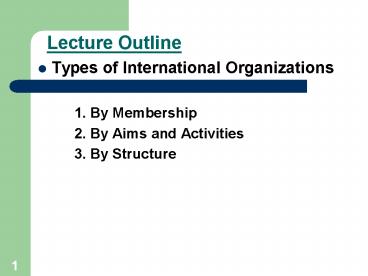Lecture Outline - PowerPoint PPT Presentation
1 / 20
Title: Lecture Outline
1
Lecture Outline
- Types of International Organizations
- 1. By Membership
- 2. By Aims and Activities
- 3. By Structure
2
Types of IOs By Membership
3
Types of IOs By Membership I. According to
the Characteristics of the Members 1.
Intergovernmental Organizations (IGOs) 2.
Transnational Organizations (TNOs) INGOs
Hybrid INGO BINGO 3. TGOII.
According to the Scope of the Membership 1.
Regional 2. Universal
4
Types of IOs By Aims and Activities
5
Every organization has certain aims specified in
the founding agreement
International Poplar Commission of FAO Asian
Coconut Community International Tin
Council International Monetary Fund The United
Nations North Atlantic Treaty Organization UEFA
6
Several classifications of IOs can be made
according to the Aims and Activities
- For instance
- A. General-Purposed Organizations
- B. Specific-Purposed Organizations
- A. Political Organizations
- B. Technical Organizations
- A. Military Security Organizations
- B. Political Organizations
- C. Economic Organizations
- A. High Political Organizations
- B. Low Political Organizations
7
Types of IOs By Aims and Activities
- Two ways of classification by aims and activities
are possible - According to areas of activity within which the
IO acts - a. General
- b. Specific
- 2. Orientation of the activities involved
- a. IOs aimed at settling disputes among members
- b. IOs designed to a common front against an
outside actor - c. IOs aimed at dealing with economic and
technical relations
8
Types of Relationships that IOs are Intended to
Create
- Encouraging Cooperative Relations
- Decreasing the level of conflict
- Crisis Management
- Conflict Management
- 3. The aim of producing a confrontation
9
Types of Relationships that IOs are Intended to
Create
- 1
- 2
- 3
Cooperation Indifference Conflict
10
Types of IOs By Structure
11
Types of IOs By Structure
- Nordic Council
- Secretariat
- Council of Ministers
- The United Nations
- SC, GA, ECOSOC, Secretariat, ICJ
12
What should be the Criteria for the
Classification of IOs by Structure?
- Distribution of institutional power among the
members - Balance between the influence of the member
states and that of the organizations
institutions - Balance between governmental and nongovernmental
representation
13
Distribution of institutional power among the
members (Institutional Power of Members)
- Power distribution in the executive organs
- OAU Council of Ministers
- UN Security Council
- 2. Voting Mechanisms in the Assembly
- UN General Assembly (or may be GA)
- IMF, IBRD
- European Union
- Majority vs. Unanimity (absolute, two third
majority) - Situation in the LN and UN
14
2. Balance between the influence of the member
states and that of the organizations institutions
- technical questions political questions
- Convergence of interests divergence of interests
- independence dependence
15
2. Balance between the influence of the member
states and that of the organizations institutions
- The more the independence of the organization
- The more the organization is successfull to
fulfill its purposes
16
2. Balance between the influence of the member
states and that of the organizations institutions
- For instance article 100 of the UN Charter
suggests that - Each member of the UN undertakes to respect the
exclusively international character of the
responsibilities of the Secretary-General and the
staff and not to seek to influence them in the
disharge of their responsibilities.
17
2. Balance between the influence of the member
states and that of the organizations institutions
- For instance the European Commission was
strengthened in the European Union.
18
3. Balance between governmental and
nongovernmental representation
- The major indicator in this distinction is that
- the extent to which organs of an international
organization contain non-governmental
representaion as opposed to governmental. - IGOs INGOs
- EU Inter-Parliamentary Union
- ILO
19
An Exercise of Cross-Classification
- Regional
- Specific Genaral
- Universal
20
A Summary of the Types of IOs
By Membership By Aims Activities By Structure
I. Characteristics of the Members 1. (IGOs)2. (TNOs) INGOs Hybrid INGO BINGO 3. TGOII. Scope of the Membership1. Regional2. Universal 1. Areas of activity within which the IO acts a. General b. Specific 2. Orientation of the activities involved a. IOs aimed at settling disputes among members b. IOs designed to a common front against an outside actor c. IOs aimed at dealing with economic and technical relations 1. Distribution of institutional power among the members 2. Balance between the influence of the member states and that of the organizations institutions 3. Balance between governmental and nongovernmental representation































